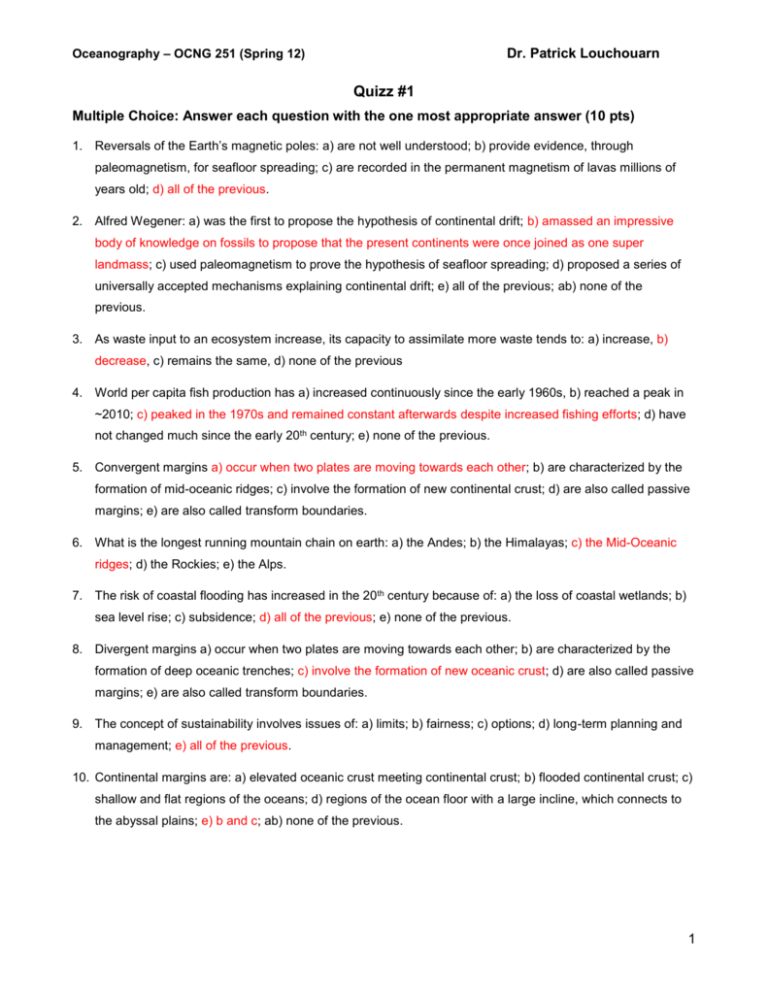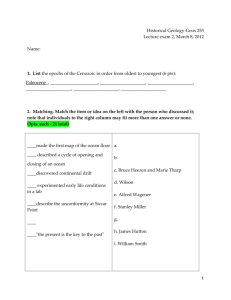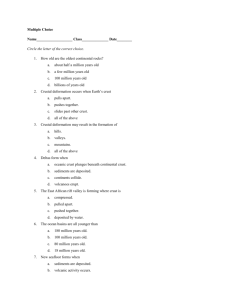Quiz 1 (Key)
advertisement

Oceanography – OCNG 251 (Spring 12) Dr. Patrick Louchouarn Quizz #1 Multiple Choice: Answer each question with the one most appropriate answer (10 pts) 1. Reversals of the Earth’s magnetic poles: a) are not well understood; b) provide evidence, through paleomagnetism, for seafloor spreading; c) are recorded in the permanent magnetism of lavas millions of years old; d) all of the previous. 2. Alfred Wegener: a) was the first to propose the hypothesis of continental drift; b) amassed an impressive body of knowledge on fossils to propose that the present continents were once joined as one super landmass; c) used paleomagnetism to prove the hypothesis of seafloor spreading; d) proposed a series of universally accepted mechanisms explaining continental drift; e) all of the previous; ab) none of the previous. 3. As waste input to an ecosystem increase, its capacity to assimilate more waste tends to: a) increase, b) decrease, c) remains the same, d) none of the previous 4. World per capita fish production has a) increased continuously since the early 1960s, b) reached a peak in ~2010; c) peaked in the 1970s and remained constant afterwards despite increased fishing efforts; d) have not changed much since the early 20th century; e) none of the previous. 5. Convergent margins a) occur when two plates are moving towards each other; b) are characterized by the formation of mid-oceanic ridges; c) involve the formation of new continental crust; d) are also called passive margins; e) are also called transform boundaries. 6. What is the longest running mountain chain on earth: a) the Andes; b) the Himalayas; c) the Mid-Oceanic ridges; d) the Rockies; e) the Alps. 7. The risk of coastal flooding has increased in the 20th century because of: a) the loss of coastal wetlands; b) sea level rise; c) subsidence; d) all of the previous; e) none of the previous. 8. Divergent margins a) occur when two plates are moving towards each other; b) are characterized by the formation of deep oceanic trenches; c) involve the formation of new oceanic crust; d) are also called passive margins; e) are also called transform boundaries. 9. The concept of sustainability involves issues of: a) limits; b) fairness; c) options; d) long-term planning and management; e) all of the previous. 10. Continental margins are: a) elevated oceanic crust meeting continental crust; b) flooded continental crust; c) shallow and flat regions of the oceans; d) regions of the ocean floor with a large incline, which connects to the abyssal plains; e) b and c; ab) none of the previous. 1 Oceanography – OCNG 251 (Spring 12) Dr. Patrick Louchouarn True and False: indicate whether the following statements are true or false (7 pts) 11. Passive margins occur where two plates slides past each other as opposed to one going under the other: a) true; b) false. 12. “Sustainability” is a term that defines economic development of human societies as a function of continuous use of natural resources: a) true; b) false. 13. Petroleum extraction has reached its peak in the US in the 1970s: a) true; b) false. 14. The vast majority of the world’s largest cities (megacities) are found in regions far from the coast: a) true; b) false. 15. The most exposed coastal zones in terms of human populations are in developed countries: a) true; b) false. 16. The world’s fisheries have reached their “peak catch” between the 1960s and 1990s: a) true; b) false. 17. Reversals of the Earth’s magnetic field served as evidence for plate tectonics: a) true; b) false. Matching: match the statements below with their subsequent counterpart (8 pts) 18. Measured ability of nations to protect the environment over the next decades d 19. Exposed coastal assets a 20. Magma plume from deep in the mantle b 21. Increased risk of flooding c 22. Divergent boundaries e 23. Liquid iron in the Earth’s core ab 24. Subduction zone ac 25. Deep earthquake occurrence ad a) Developed countries b) Hotspot c) Coastal subsidence d) Sustainability index e) Mid-oceanic ridges ab) Planetary magnetic field ac) Convergent boundary ad) Pacific Ocean Basin 2 Oceanography – OCNG 251 (Spring 12) Dr. Patrick Louchouarn Interpreting graphs (2 pts): 26. The picture of the Red Sea below, was used to make what point in class? a) The Red Sea is an example of a juvenile ocean basin, b) the Red Sea is a link between Indian Ocean and the Gulf of Oman, c) The red Sea is an example of a terminal (closing) ocean basin, d) The Red Sea looks like a slug from space, e) none of the previous. 27. The Figure below suggests that: a) the western Pacific is very young, b) the south Atlantic opened several million years after the north Atlantic, c) the ocean basins became a feature on the surface of Earth 250 million years ago, d) the age distribution of oceanic crust is an additional evidence supporting plate tectonics, e) all of the previous, ab) b and d. 3 Oceanography – OCNG 251 (Spring 12) Dr. Patrick Louchouarn Bonus Multiple Choice Questions: Answer each question with the one most appropriate answer on the separate Scantron sheet – Remember to put your name! (10% max) 1) In 1898, Spain signed a treaty officially ending the Spanish-American War. What did it give the United States? a) Guam, b) Puerto Rico, c) the Philippines, d) the Virgin Islands, e) Jamaica, ab) b, d, and e, ac) a, b, and c, ad) a, b, and d. 2) Who is Dexter’s nemesis? a) Gaku; b) Raku; c) Mandark; d) Aku; e) Didi. 3) What is the French name of Tintin’s dog? a) Mili, b) Milou, c) Rex, d) Tom, e) Captain. 4) Which book from Ernest Hemingway takes place in Cuba? a) Death in the Afternoon; b) The old Man and the Sea; c); The Sun Also Rises d); To Have and to Have Not; e) b and d; ab) a, b and c . 5) Who is credited with having invented the bifocal glasses? a) Sir Isaac Newton; b) Galileo; c) Thomas Edison; d) Benjamin Franklin; e) Leonardo Da Vinci. 6) Which formula in the following set does NOT represent the volume of a sphere? a) 4/3 r3; b) 1/6d3; c) 16/9 /4 3r3; d) 8/2 r3/3; e) 12/4 r3/3. 7) Which Romantic French poet is the author of the poem “The Albatross”? a) Rimbaud; b) Verlaine; c) Baudelaire; d) Prévert; e) Cocteau. 8) What international soccer star won a league title with three different clubs in three different countries? a) Zinedine Zindane; b) Ronaldo; c) Pele; d) David Beckham; e) Lionel Messi. 9) What contemporary pop group is the author of these lyrics “And we can’t run and we can’t cheat, cause baby when we meet what we’re afraid of, we find out what we’re made of”? a) Indigo Girls; b) Eurythmics; c) Pink; d) Everything but the Girl; e) U2. 10) In 1986, which hockey team did the Montreal Canadians beat in the Stanley Cup finals (at their home!)? a) Dallas Stars; b) New York Rangers; c) Calgary Flames; d) Edmonton Oilers; e) None of the previous. 4








